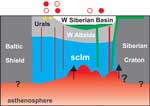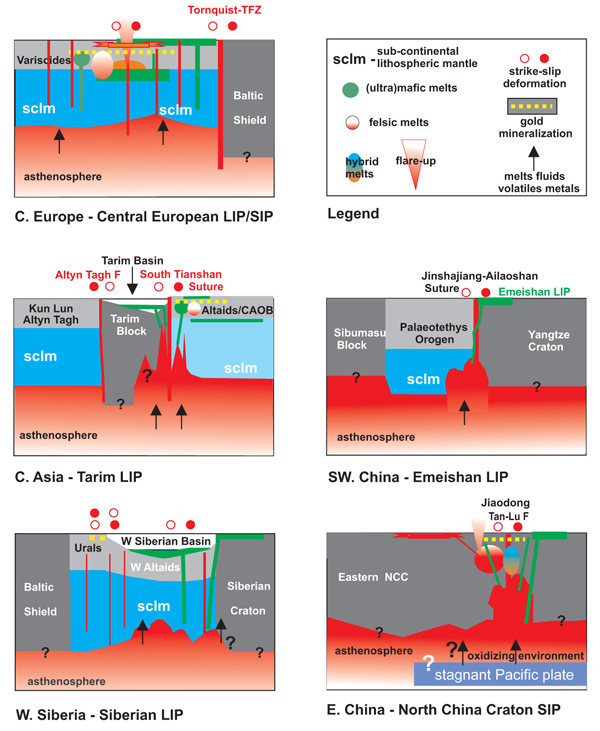 |
The Jiaodong gold district, northeastern China: Late Paleozoic and Late Mesozoic LIPs, orogeny and metallogeny in Eurasia |
Hugo de Boorder
Institute of Earth Sciences, Utrecht University, Utrecht, The Netherlands; H.deBoorder@uu.nl
This webpage is a summary of: de Boorder, H., The Jiaodong gold district, northeastern China, in the context of the Late Paleozoic and Late Mesozoic large igneous provinces, orogeny and metallogeny in Eurasia, Ore Geology Reviews, 65, 574–588, 2015.
This summary focuses on three entangled issues:
-
the timing and localisation of orogenic gold deposits, as expressions of orogenic processes, involving fluids liberated by metamorphic devolatilisation and/or magmatic-hydrothermal processes [1,2],
-
the coincidence of ore formation with the emplacement of large and scattered igneous provinces as expressions of mantle processes [3,4,44],
-
the relation of orogenic gold deposits with active mantle plumes [5,6,44].
I have discussed these topics on the basis of Permo-Carboniferous gold deposits in the West European Variscan and Central Asian Southern Tianshan Orogens, the Palaeotethys orogen in southwestern China, and the Permo-Triassic Western Altaids in Siberia [3,4]. Orogenic gold deposits are gold lodes within and associated with metamorphic belts [1,7,8,9]. In the above orogens, isotope-geochronological estimates suggest that the ore deposits were formed late in the orogenic history or even after orogeny had demonstrably ended [3,4,10,11]. During the same interval, late- and post-orogenic and A-type granitoids and gabbroids were emplaced, together with felsic and mafic volcanics, often with trace-element assemblages indicative of subduction, paradoxically at a time when subduction had already ended. In western Europe the igneous complexes involved were first taken together as a scattered igneous province [12,13] and later as the Central European Large Igneous Province [14]. In central Asia, the Tarim Large Igneous Province is coeval with a comparable association in the Southern Tianshan. In southwestern China, the Emeishan Large Igneous Province was recently viewed in connection with the closure of the Palaeotethys Ocean [15]. In western Siberia, the Siberian Large Igneous Province, host of diverse ore deposits [16,17], followed on to the demise of the western part of the Altaids between the Siberian Craton and the Baltic Shield. Why were these ore deposits and diverse melts formed so late?

Figure 1: Schematic summaries of the five inferred LIP/SIP settings relative to cratons and orogenic belts. In all five cases subduction of lithospheric plates took place.
The answers are generally sought in relatively shallow mantle processes: detachment of an orogenic root and/or a subducted lithosphere slab, slab roll back, and delamination of the subcontinental mantle lithosphere. Yet the flood basalts, clearly manifested in the Tarim LIP, in relatively small outcrops and subsurface domains in the Central European LIP, and the vast volumes of the Siberian LIP, have long been attributed to active mantle plumes. However, in western Europe consensus has steered away from a plume mechanism towards widespread extension following orogeny, while the origins of the Siberian LIP [18] and the Tarim LIP [19,20,21] are probably more complex. The Siberian LIP and the Emeishan LIP tend to continue as platforms of the plume hypothesis but relations with prominent strike-slip deformation [22] and a decaying orogen [15] have been invoked as well.
The upwelling of asthenospheric complexes consequent upon slab and/or root detachment or lithosphere delamination is generally recognised. However, the consequences of associated uplift and collapse of the orogen are not normally appreciated. The significance of these mantle processes is that energy and material were supplied to the defunct orogenic belt as heat, magma, fluids and volatiles from newly-involved, non-orogenic sources, namely, the lower continental lithospheric mantle and the asthenosphere. (Ultra)mafic melts may become arrested at the Moho and/or within the crust or extruded at the surface as flood basalts and felsic differentiates together with rhyolite lavas and ignimbrite flare-ups from crustal melts [23-28]. Mafic dyke swarms are locally recognised as feeders of the flood basalts [29].
In studies of the tectonic setting of orogenic gold deposits, translithospheric strike-slip deformation is often seen to dissect the old orogenic belt, as in the Variscides and the Southern Tianshan along the suture zone of Gondwana and Laurasia [30-33]. Although again recognised, the role of this deformation in the lithospheric permeability network is not normally elaborated. In addition to the overall uplift of the orogenic belt, translithospheric strike-slip deformation may provide not only for localised deep decompression and consequent (partial) melting in the subcontinental mantle but also for localised inversion. Uplift-related decompression may lead to potentially mineralising fluids rather than increasing temperature associated with prograde regional metamorphism [34].
It follows that:
- orogenic gold deposits could be the result of non-orogenic, relatively shallow mantle processes,
- consistent with the emplacement of LIPs and SIPs as expressions of the same shallow mantle processes, which are
- unrelated to active plume processes.
The setting of other gold provinces could possibly provide further clarity. Here, the Jiaodong gold province may turn out to be key to progress in interpretation. The deposits are in large part mesozonal gold lodes and have been categorised as anorogenic [35] and as orogenic deposits [36]. This issue was recently addressed again [37] in light of earlier suggestions concerning the uniqueness of the Jiaodong deposits [38]. The main difficulty with their classification as orogenic gold is in the much older, Precambrian, ‘cooked out’ host complexes of the North China Craton instead of a (plutono-) metamorphic belt with potential source rocks, critical to the nature of orogenic gold deposits proposed in the original definition [1]. In eastern China, there is no relevant hosting orogen, although subduction of the Pacific plate, currently stalled, is not in doubt [39-41]. However, recognised elements of the orogenic gold model are in the hosting transcurrent, translithospheric Tan-Lu Fault Zone, and uplift of the eastern part of the craton with localised exhumation of Precambrian blocks. The setting of this province is further characterised by the destruction of the root of the hosting eastern part of the North China Craton, the subduction zones around the craton with long-term hydration and metasomatism of the mantle [42], partial melting of subducted lithosphere slabs with enrichment of mantle-incompatible elements, underplating of hydrous mafic magmas with consequent crustal melting and formation of volcanics including flares of ignimbrite and basaltic trachyandesite [23,24,28], together recognised as a scattered igneous province [6,43]. Collectively, these features epitomize the associations in Eurasia observed above. The anorogenic Jiaodong gold deposits are not necessarily unique. Instead, they may constitute an archetype of ‘mesothermal’, ‘mesozonal’ and ‘orogenic’ gold deposits.
References
1 Groves, D.I. et al., 1998. Ore Geology Reviews 13, 7-27.
2 Sillitoe, R.H., Thompson, J.F.H., 1998. Resource Geology 48, 237-250.
3 De Boorder, H., 2012. Ore Geology Reviews 46, 1-31.
4 De Boorder, H., 2014. Global Tectonics and Metallogeny 10(1), 1-22.
5 Pirajno, F., 2010. Journal of Geodynamics 50, 325–346.
6 Pirajno, F., Santosh, M., 2014. Ore Geology Reviews 63, 265-295.
7 Bohlke, J.K., 1982. U.S. Geol. Surv., Open-file Rep. 795, 70–76.
8 Böhlke, J.K., Kistler, R.W., 1986. Economic Geology 81, 296–322.
9 Goldfarb, R.J. et al., 2005. Economic Geology 100th Anniversary Volume, 407-450.
10 White, S.H. et al., 1992. In: R. Foster (Editor), Mineral Deposits Modelling in Relation to Crustal Reservoirs of Ore-forming elements. Extended Abstract, IMM, London, 4 pp.
11 De Boorder, H. et al., 1998. Earth and Planetary Science Letters 164, 569-575.
12 Doblas, M. et al., 1998. Journal of African Earth Sciences 26, 89-99.
13 Perini, G. et al., 2004. Geological Society, London, Special Publications 223, 415-438.
14 Dobretsov, N.L., et al., 2010. Russian Geology and Geophyics 51, 903-924.
15 Jian, P. et al., 2009. Lithos 113, 767-784.
16 Duzhikov, O.A., Strunin, B.M., 1992. Society of Economic Geologists Special Publication 1, 1-60.
17 Borisenko, A.S. et al., 2006. Russian Geology and Geophysics 47, 166-182.
18 Ivanov, A., 2007. Geological Society of America Special Paper 430, 669-691.
19 Xu, Y.-G., 2001. Physics and Chemistry of the Earth (A) 26(9-10), 747-757.
20 Zhang, C.-L., Zou, H.-B., 2013. Lithos 172-173, 47-60.
21 Wan, B. et al., 2013. Lithosphere 5(3), 290-299.
22 Allen, M.B. et al., 2006. Journal of the Geological Society 163, 901-904.
23 Benek, R. et al., 1996. Tectonophysics 266, 379-404.
24 Breitkreuz, C., Kennedy, A., 1999. Tectonophysics 302, 307-326.
25 Henk, A. et al., 1997. Journal of Geology 105, 367-378.
26 Féménias, O. et al., 2003. Chemical Geology 199, 293-315.
27 Tian, W. et al., 2010. Contibutions to Mineralogy and Petrology 160, 407-425.
28 Yang, Q.-Y., Santosh, M., 2014. Ore Geology Reviews.
29 Lightfoot, P.C., Evans-Lamswood, D., 2014. Ore Geology Reviews (2014).
30 Arthaud, F., Matte, Ph., 1977. Geological Society of America Bulletin 88, 1305-1320.
31 Bard, J.-P., 1997. Comptes Rendues de l’Académie des Sciences, Paris 324, sér. II a, 693-704.
32 Natal'in, B.A., ?engör, A.M.C., 2005. Tectonophysics 404, 175–202.
33 Laurent-Charvet, S. et al., 2003. Tectonics 22, doi:10.1029/2001TC901047.
34 Yardley, W.D., Cleverley, J.S., 2013. Geological Society, London, Special Publications, 393.
35 Zhai, M.G., et al., 2004. Earth Science Frontiers, 2004-01.
36 Goldfarb, R.J. et al., 2007. Economic Geology 102, 341-345.
37 Goldfarb, R.J., Santosh, M., 2013. Geoscience Frontiers (in press).
38 Zhai, M.G., Santosh, M., 2013. Gondwana Research 24, 275-297.
39 Zhao, D, 2004. Physics of the Earth and Planetary Interiors 146, 3-34.
40 Zhao, D., 2009. Gondwana Research 15, 297-323.
41 Zhao, D. et al., 2010. Russian Geology and Geophysics 51, 925-938.
42 Tan, J. et al., 2012. Ore Geology Reviews 48, 70–87.
43 Pirajno, F., 2013.The Geology and Tectonic Setting of China’s Mineral Deposits. Springer Science & Business, Dordrecht, pp 679.
44 Ernst, R.E., Jowitt, S.E., 2013. Society of Economic Geologists, Inc., Special Publication 17, 17-51.
last updated 4th January, 2015 |
